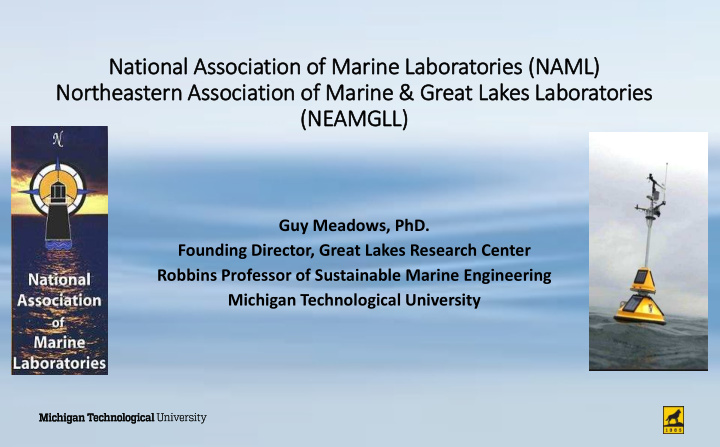



Nation onal A Assoc ociation on o of Marine Labor oratori ories ( (NAML) Northeastern rn A Assoc ociation on of Marine & & Great L Lakes Labor oratori ories (NEA EAMG MGLL) Guy Meadows, PhD. Founding Director, Great Lakes Research Center Robbins Professor of Sustainable Marine Engineering Michigan Technological University
The Great Lakes • Economic Value • Coastal Resiliency with rising water levels • Risk Analysis • Ice/Winter Observations Great Lakes Research Center Date
Value of the Great Lakes and St. Lawrence Basin • Eight States and Two Providences • Population 107 million • Jobs 51 million • Largest group of freshwater lakes on Earth by total area • 84% of North America's surface fresh water • 21% of the world's supply of surface fresh water • Third largest combined economy in the world • >50% of all U.S./Canadian bilateral border trade • Over 200 million tons of cargo shipped annually • GDP US $6 trillion
Coastal Resiliency – High Waves and High Water • Lake Michigan water levels rise 2013 – 2019 • 6 feet rise in 6 years…1 ft/year • East coast sea level rise past 100 years • 5 – 8 inches ! • Breaking 100+ year records
Great Lakes Serve as an Example to Coastal Ocean
A “Teachable Moment” • An 80 – Year look at the shoreline • Educating coastal communities, property owners and coastal planners
Risk Analysis: Protecting the Environment and Underwater Infrastructure Reduced survey time from years to two days Enbridge Pipeline
Independent Risk Analysis for the Straits of Mackinac for the State of Michigan
Project Scope
Advanced Supercomputing Cluster: Numerical Modeling for Great Lakes Section Team: Chief Scientist: Pengfei Xue (MTU) Example: Dec. 27 scenario identified as worst case for Task C Section Authors: David Shonnard (MTU), David Schwab (UM), Philip Chu (NOAA), Eric Anderson (NOAA) 10 Section Lead: Gordon Paterson (MTU)
Punchline • Marine Labs Brought in as the “Honest Broker” • Science was not challenged by • Companies • Federal or State Agencies • General Public
Winter Observations for the Great Lakes and “Arctic Like” Coastlines • Scientifically Blind November – April (Lake Superior) • No real-time observations • No ships, buoys, gliders, people on the water • Developing Cost Effective Cabled Observatories and Autonomous Technologies
February 20, 2014 92.5 % Great Lakes Ice Cover The “Arctic” You Can Drive To
Thank You For Your Support! Questions ?
Recommend
More recommend